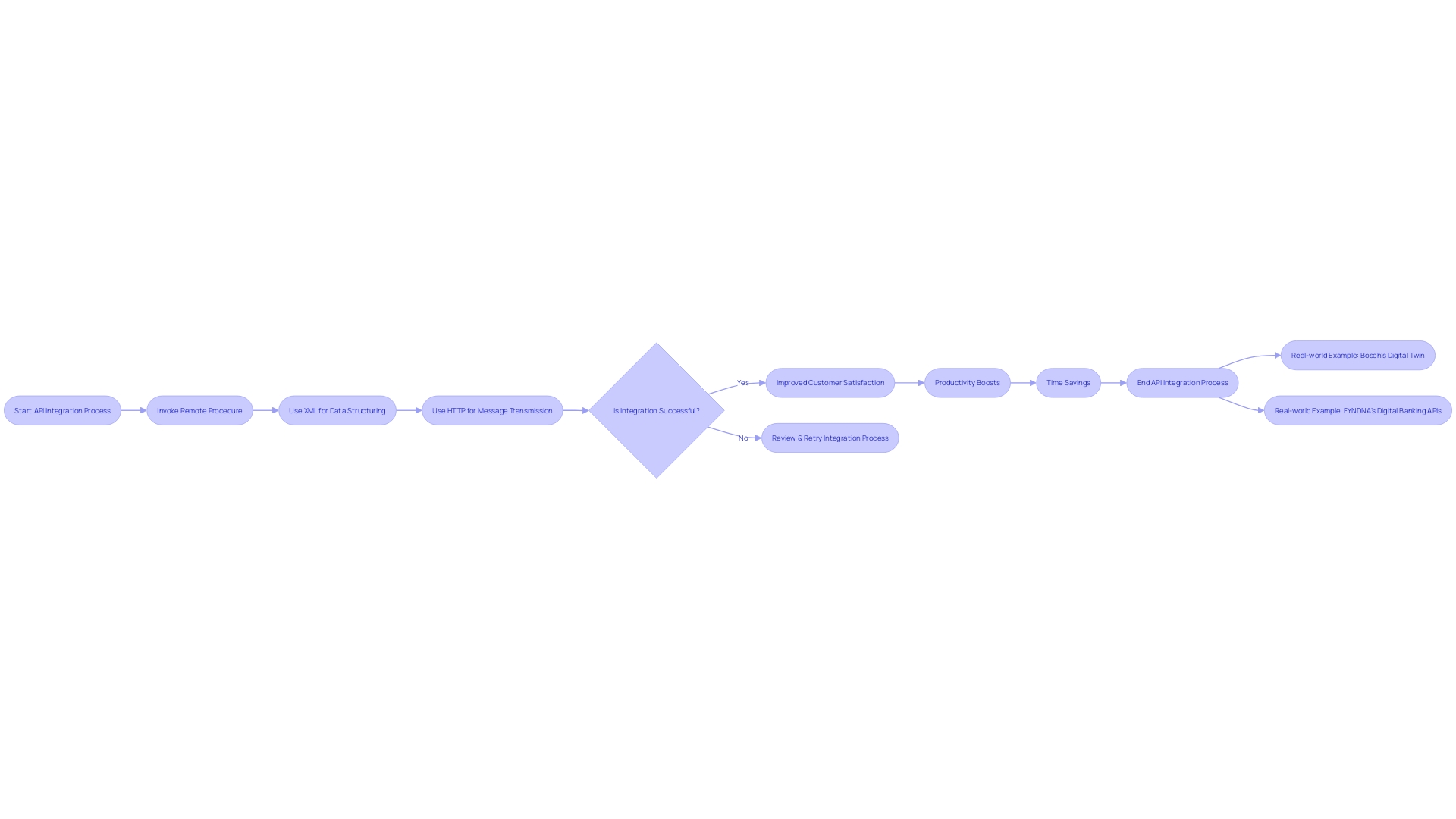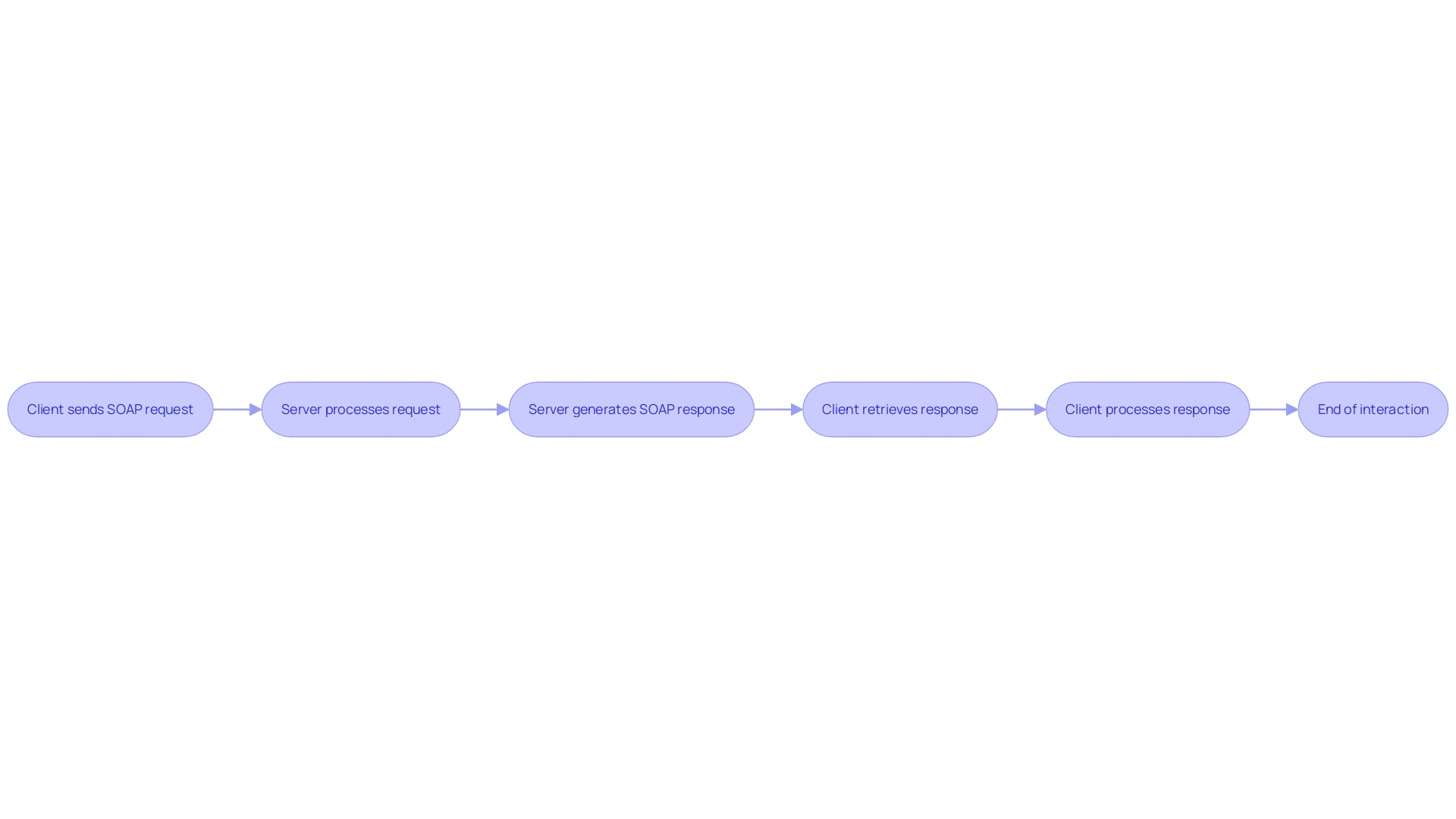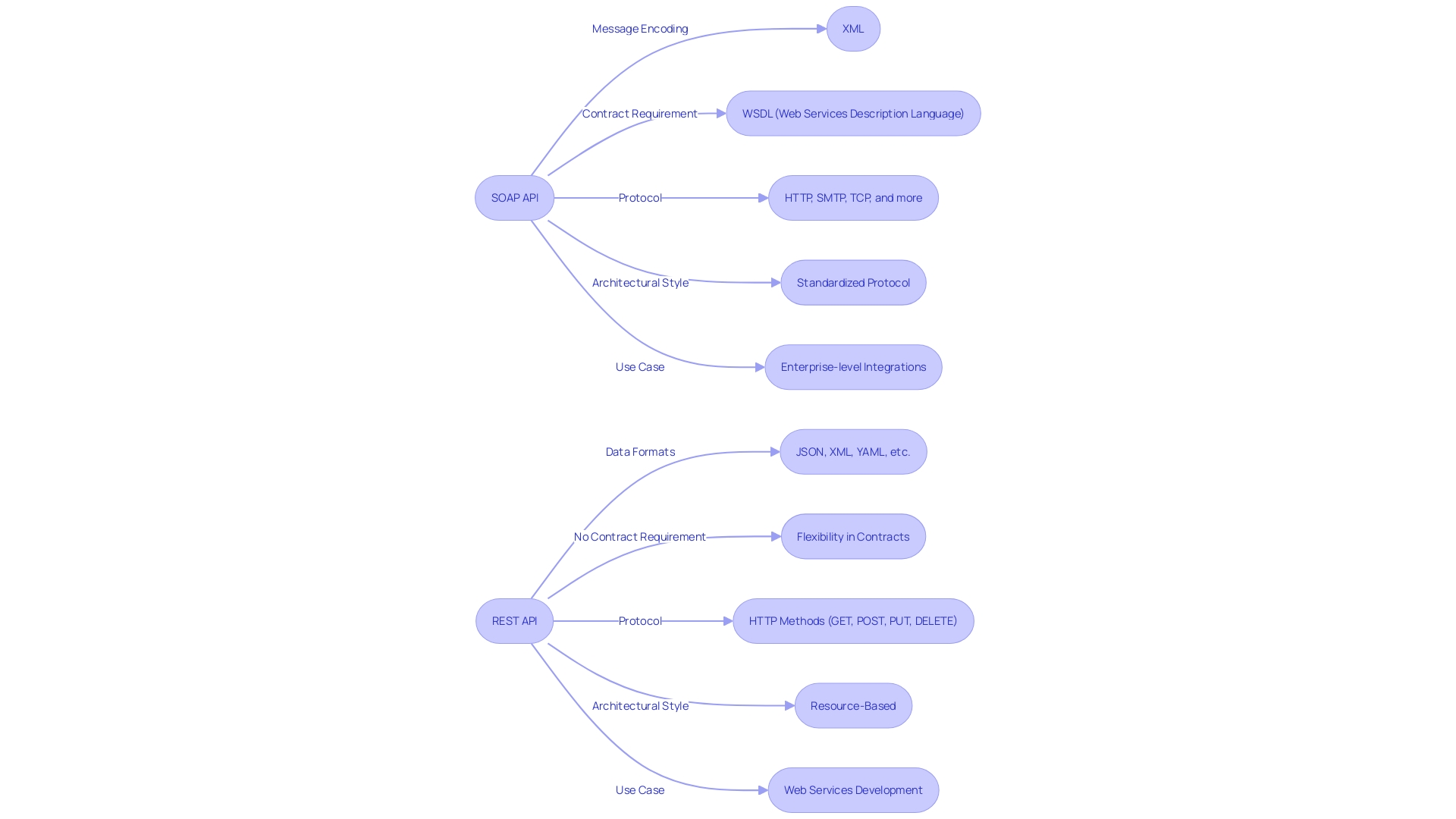Introduction
API integration is crucial for seamless communication between applications, particularly in complex enterprise environments. SOAP (Simple Object Access Protocol) APIs, which utilize XML for data structuring and HTTP for message transmission, provide a reliable and standardized method for invoking remote procedures and exchanging information. In a recent study, 93% of organizations recognized APIs as crucial to their operations, and 97% agreed on the synergistic relationship between APIs and microservices, leading to improved customer satisfaction, productivity boosts, and time savings.
This article explores the benefits and outcomes of using SOAP API, with real-world examples highlighting its role in enhancing sustainability efforts and meeting customer expectations in the financial sector. We'll also delve into the key components of SOAP API, its comparison with REST API, and best practices for implementing SOAP API to achieve optimal performance, security, and maintainability.
II. What is SOAP API?
SOAP (Simple Object Access Protocol) APIs are vital for the seamless interaction between applications, particularly in complex and large-scale enterprise environments. They utilize XML for structuring data and typically employ HTTP for message transmission, ensuring a reliable and standardized method for invoking remote procedures and exchanging information.
The significance of efficient API integration is underscored by the astounding 93% of organizations recognizing APIs as crucial to their operations, as highlighted in a 2021 study by Vanson Bourne. Moreover, the same research indicated a strong consensus (97%) on the synergistic relationship between APIs and microservices, linking their integration to improved customer satisfaction, productivity boosts, and time savings.
Bosch's implementation of a digital twin for their solid oxide fuel cell system exemplifies the power of API integration in enhancing sustainability efforts. By visualizing and monitoring the system's health, Bosch leverages API technology to optimize performance and cost-effectiveness throughout the product's lifespan, contributing to a more sustainable energy landscape.
Similarly, India's FYNDNA, a fintech innovator, harnesses the potential of digital banking APIs to meet escalating customer expectations and maintain service continuity. Their dedication to robust API infrastructure is a testament to the pivotal role APIs play in fostering digital transformation and ensuring financial services remain agile and responsive in the face of rapid industry evolution.

III. How SOAP API Works
Consider the interaction between a client and server via a SOAP API, which operates akin to a well-orchestrated conversation. The client initiates the dialogue by sending a SOAP request, neatly packaged within an XML envelope. This envelope is the carrier of vital information, including the specific method to be invoked and the essential input parameters required for the operation.
Upon receipt, the server takes on the role of a diligent processor, executing the necessary actions and crafting a SOAP response. Mirroring the request, the response, too, comes enveloped in XML, now bearing the fruits of the server's labor—the output or results.
Finally, the client retrieves and processes the response, extracting the valuable data from the XML envelope for its use. This back-and-forth exchange is reminiscent of Bosch's innovative SOFC system, where digital monitoring tools ensure the high-efficiency, low-emission production of electrical power and heat. Similarly, FYNDNA's vision of digitally-enabled banking solutions in India highlights the importance of seamless and reliable API interactions to meet growing customer expectations and maintain trust.

IV. Key Components of SOAP API
The SOAP API architecture comprises several integral components that together enable its operation and versatility. At its core lies the SOAP Envelope, a structure that encompasses the complete SOAP message, delineating the XML namespaces that dictate the message's semantics and serialization. Within this envelope, we find the SOAP Header, which, although optional, can carry essential application-specific details that pertain to the SOAP message such as transactions, authentication, and more.
Central to the message is the SOAP Body, tasked with transporting the actual payload of the request. It details the specific method to invoke along with any necessary input parameters, forming the crux of the message's intent and action. In the event of an error, the SOAP Fault element steps in, providing structured error and status information to enable effective troubleshooting and communication of issues.
Complementing these elements is the WSDL (Web Services Description Language), an XML-based framework that meticulously outlines the capabilities, interfaces, and protocols of the SOAP API. It serves as a blueprint, allowing clients to comprehend and interact with the API's services accurately and efficiently.
Through the lens of case studies, such as Bosch's implementation of their solid oxide fuel cell (SOFC) system, we can observe the real-world significance of digital twins in monitoring and optimizing system performance over time. Similarly, FYNDNA's approach in the financial sector highlights the importance of reliable and adaptable digital solutions to meet rising customer expectations and technical demands, akin to the adaptability and robustness provided by a well-structured SOAP API.
Furthermore, current trends underscore the importance of API analytics, recognizing APIs as strategic assets rather than mere communication channels. As reported, API analytics have become a pivotal tool, yielding insights that influence business strategies and enhance user experiences, much like how the SOAP Fault element informs on service disruptions, playing a vital role in maintaining trust and reducing downtime.
In conclusion, the collective orchestration of the SOAP API's components not only facilitates seamless interaction between disparate systems but also embodies the principles of innovation and efficiency, as evidenced by leading technology adopters and industry pioneers.
V. SOAP vs. REST API: Key Differences
-
SOAP (Simple Object Access Protocol) API and REST (Representational State Transfer) API represent two distinct approaches in the realm of web services and application interfaces. SOAP is a protocol with stringent standards and relies on XML (Extensible Markup Language) to encode messages. It demands a well-defined contract, known as WSDL (Web Services Description Language), for any interaction with the API. This makes SOAP a go-to choice for complex, enterprise-level integrations where robust security and transactional reliability are paramount.
-
On the other side of the spectrum, REST is an architectural style that embraces flexibility, allowing various data formats, including JSON (JavaScript Object Notation), which is particularly favored for its lightweight nature and ease of use. REST APIs harness the simplicity of HTTP methods such as GET, POST, PUT, and DELETE, making them more intuitive and straightforward to work with. This architectural style is often the preferred choice for modern, lightweight applications that prioritize quick, resource-oriented interactions over the heavy-duty, service-oriented approach of SOAP APIs.
-
The practical implications of these differences are evident in case studies from major organizations like Microsoft and SmartBear, which emphasize the need for efficient, scalable, and secure API designs that align with the company's technological and ethical standards. In an era where 78% of cybersecurity teams have faced API-related security incidents in the past year, the choice between SOAP and REST can significantly impact an organization's vulnerability to cyber threats. The flexibility of REST APIs, coupled with the robustness of SOAP, provides developers with a powerful toolkit to address the evolving challenges of API security and efficiency in software development.

VI. Advantages and Disadvantages of SOAP API
SOAP APIs serve as a robust communication protocol in the digital landscape, where interoperability and error management are critical for seamless integration. These APIs excel in handling intricate data structures, which is essential for complex enterprise solutions. The built-in error handling and fault reporting mechanisms of SOAP APIs offer a layer of reliability that can be particularly advantageous in high-stakes environments where precision is paramount.
On the flip side, the complexity and extensive resource requirements of SOAP APIs might pose a challenge, especially when lightweight and swift alternatives are available. This complexity often translates to a steeper learning curve for developers, especially those accustomed to more straightforward services like REST APIs. The added complexity can lead to increased processing time and bandwidth consumption, which might not align with the needs of every project or organization.
To put this into perspective, companies like Bosch have leveraged the power of APIs to develop their solid oxide fuel cell (SOFC) systems, combining physical and digital engineering expertise to enhance energy efficiency. Similarly, Rackspace Technology emphasizes the importance of adapting to rapid advancements in digital solutions, highlighting the pivotal role that APIs play in fostering innovation and efficiency across various domains.
As the software industry evolves, the significance of APIs is further underscored by their ability to enable real-time data exchange and integration. This was not always the case; previously, systems like Electronic Data Interchange (EDI) dominated the scene, offering a standardized but rigid format for business communication. The agility and direct communication offered by modern APIs represent a quantum leap from the early automated systems, addressing the need for more dynamic, real-time data exchange.
In conclusion, while SOAP APIs may have certain drawbacks in terms of complexity and resource demands, their robustness and reliability make them an invaluable tool in scenarios where error handling and sophisticated data transactions are required. Developers and organizations must weigh these factors carefully to choose the API that best fits their specific needs and objectives.
VII. Use Cases for SOAP API
SOAP APIs, with their robust protocols and standards, are indispensable for complex and secure integrations in various sectors. For example, in enterprise application integration, they facilitate data and functionality sharing across different applications, enhancing operational cohesion. Financial systems also rely on SOAP APIs for secure data transmission and to execute intricate processes like fund transfers and processing transactions.
Healthcare systems leverage SOAP APIs for the secure exchange of sensitive patient information, ensuring consistent data integrity and interoperability. These APIs are central to maintaining high standards of data protection and efficient healthcare delivery.
In the realm of sustainability and innovation, companies like Bosch utilize digital twins, supported by APIs, to monitor and optimize performance over the lifetime of their solid oxide fuel cell systems. Similarly, TotalEnergies Digital Factory employs APIs to modernize legacy systems, developing over 80 solutions since 2020, showcasing the transformative power of API integration across industries.
Considering the security implications, APIs must be designed with care, as they expose application logic and sensitive data. The recent acquisition of Software AG's platforms by IBM underscores the importance of enterprise integration platforms in enhancing AI and hybrid cloud offerings.
APIs are not just technical constructs; they are the translators that enable seamless communication between diverse software programs. They are the unsung heroes of modern software development, making it possible for developers to create more complex and powerful applications by connecting with other services. As the digital world evolves, the role of APIs only grows more vital, becoming the backbone of innovation and collaboration.
VIII. Comparison with Other APIs (REST, JSON, GraphQL)
While SOAP API has been a steadfast approach in web services, it's essential to understand its place amid evolving API paradigms such as REST, JSON, and GraphQL. REST, a resource-centric API style, stands out for its flexibility, allowing straightforward data exchange between client and server. Unlike Soap's strict protocol constraints, REST communicates using standard HTTP methods, making it a preferred choice for web APIs.
JSON, a minimalist data format often paired with REST, contrasts starkly with Soap's XML format. Its simplicity and lightweight nature make JSON appealing for quick data interchange. For instance, TotalEnergies Digital Factory leverages APIs, relying on the agility of formats like JSON to modernize systems and deploy numerous digital solutions globally.
GraphQL takes API interaction further by enabling precise data querying, which solves common issues of over-fetching or under-fetching associated with REST. This tailored data fetching is not just an efficiency booster but also a cost-reducer, as seen in Bosch's implementation of their SOFC system. Their digital twin technology uses similar principles to GraphQL, ensuring optimal performance and cost-effectiveness throughout the system's lifecycle.
Webhooks, likened to instant notifications as opposed to the constant polling of traditional methods, represent another shift towards more efficient and responsive API interactions. This event-driven mechanism exemplifies the move towards real-time data synchronization between services.
The continuous evolution in API technologies reflects the industry's drive towards more efficient and adaptable solutions. With the tech sector's growth and the rising number of developers, as indicated by recent trends showing 13.4 million professionals worldwide, the choice of API technology must align with the project's specific requirements and the broader goal of sustainable and accessible energy, as championed by companies like Bosch and TotalEnergies.
IX. Best Practices for Implementing SOAP API
Ensuring optimal performance, security, and maintainability is crucial when implementing a SOAP API. Here are some best practices to consider:
-
Utilizing WSDL: The Web Services Description Language (WSDL) acts as a contract for your SOAP API, clarifying the available operations and facilitating client interactions. It's akin to a blueprint, guiding developers on how to correctly connect and use the API's services.
-
Implementing Security Measures: Security is non-negotiable, and SOAP APIs are no exception. Embrace security standards such as WS-Security and HTTPS to shield sensitive information from unauthorized access. Think of these as the protective walls that keep your SOAP API safe from intruders.
-
Error Handling and Fault Reporting: A robust error handling strategy is essential. It ensures that clients are not left in the dark when issues arise, providing meaningful feedback that can be used to efficiently resolve problems.
-
Performance Optimization: To enhance your SOAP API's performance, focus on minimizing data transfers, caching responses, and refining data serialization and deserialization processes. Efficiency here reduces the overhead on both the server and client, leading to a smoother user experience.
-
Comprehensive Documentation: Just as Bosch provides a digital twin for its SOFC system to facilitate optimization over its lifecycle, your SOAP API documentation should serve as a comprehensive guide. Include usage examples, guidelines, and best practices. This detailed documentation is a vital tool for developers, enabling them to integrate and utilize your API with greater ease and effectiveness.
Conclusion
In conclusion, SOAP API is a reliable and standardized method for seamless communication between applications in complex enterprise environments. It utilizes XML and HTTP to ensure efficient and secure interactions. Real-world examples, such as Bosch's digital twin implementation and FYNDNA's use of digital banking APIs, highlight the benefits of SOAP API in enhancing sustainability efforts and meeting customer expectations in the financial sector.
SOAP API's key components, including the SOAP Envelope, SOAP Header, SOAP Body, SOAP Fault, and WSDL, work together to facilitate secure and efficient interactions between clients and servers.
SOAP API excels in complex integrations that require robust security and transactional reliability, making it a preferred choice for enterprise-level solutions.
While SOAP API may have some complexity and resource requirements, its advantages include the ability to handle intricate data structures and ensure reliable data transmission.
SOAP API is widely used in sectors such as enterprise application integration, finance, and healthcare, where secure data transmission and complex processes are crucial.
Implementing SOAP API effectively involves following best practices, such as utilizing WSDL, implementing security measures, having a robust error handling strategy, optimizing performance, and providing comprehensive documentation.
In summary, SOAP API is a powerful tool for seamless communication in complex enterprise environments. By leveraging its benefits and following best practices, developers can achieve maximum efficiency and productivity in their applications.
Frequently Asked Questions
What is a SOAP API?
SOAP (Simple Object Access Protocol) API is a protocol used for exchanging structured information in the implementation of web services. It relies on XML for data structuring and typically uses HTTP for transmitting messages.
Why are SOAP APIs important for organizations?
SOAP APIs are crucial for seamless application interaction, especially in complex and large-scale enterprise environments. They are recognized as essential for operations and integration with microservices, leading to improved customer satisfaction and productivity.
How does a SOAP API work?
A SOAP API works by facilitating a conversation between a client and a server. The client sends a SOAP request wrapped in an XML envelope. The server then processes this request and sends back a SOAP response, also in XML, which the client processes to extract the needed data.
What are the key components of a SOAP API?
The key components include the SOAP Envelope, SOAP Header (optional), SOAP Body, and SOAP Fault. Together, they encompass the SOAP message, provide application-specific details, carry the payload, and offer error information for troubleshooting.
How does SOAP API differ from REST API?
SOAP is a protocol with strict standards and uses XML for encoding messages, while REST is an architectural style that supports various data formats like JSON and uses simple HTTP methods. SOAP is ideal for complex, secure transactions, whereas REST is better for lightweight, resource-oriented interactions.
What are the advantages and disadvantages of SOAP API?
Advantages include handling complex data structures, built-in error handling, and fault reporting for reliability. Disadvantages consist of complexity, resource intensity, and potentially slower processing time compared to simpler alternatives like REST APIs.
What are some use cases for SOAP API?
Use cases include enterprise application integration, financial systems for secure data transmission, healthcare systems for exchanging sensitive patient data, and sustainability initiatives like digital twin technologies for system monitoring and optimization.
Can you compare SOAP API with other APIs like REST, JSON, and GraphQL?
REST is more flexible and suitable for web APIs, JSON is a lightweight data interchange format often used with REST, and GraphQL allows precise data querying to avoid over-fetching or under-fetching. SOAP remains steadfast for standard-based and secure communication.
What are some best practices for implementing SOAP API?
Best practices include utilizing WSDL for clear operations, implementing security measures like WS-Security and HTTPS, robust error handling, performance optimization, and comprehensive documentation to guide developers in integrating and using the API effectively.




